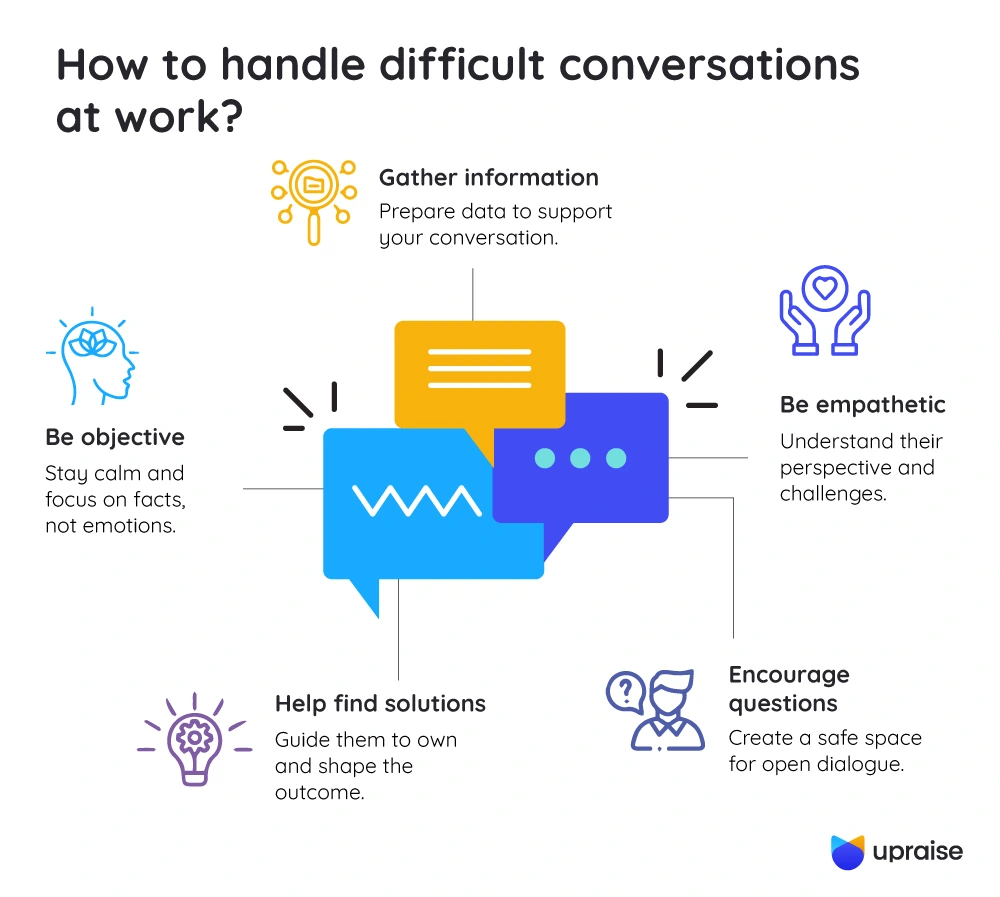We need to talk. Four simple words are enough to make the best of us nervous. How often do we avoid someone just to skip a tough conversation? Not just personally, but in our professional lives too.
According to a study by Bravely, 70% of employees try to avoid difficult conversations at work, whether with their boss or colleagues. However, difficult conversations may be essential in certain situations. For example, if someone consistently performs below average, they need guidance to get back on track. It is their manager’s (and teammates’ in some cases) responsibility to find the root cause behind the problem. While it may not be a pleasant task, it certainly cannot be avoided.
Fortunately, there are certain steps that you can take to prepare for difficult conversations. This article will explore how to have difficult conversations at work, key principles and a real-world case study.
How to handle difficult conversations at work?
Having difficult conversations at work can become easier with these five techniques:

1. Be objective
The very first thing that you should do is to control your emotions. Some conversations can get heated, especially if the employee is frustrated or feels unheard. Tempers may flare, and voices may be raised to get one’s point across.
You want to have a meaningful conversation with the other person. Avoid turning the conversation into a confrontation, even if emotions are running high. By controlling your emotions and speaking objectively, you will be better able to convey the point of that meeting. If you too get angry, you could end up saying things in the heat of the moment that could have worse repercussions.
2. Gather information
Gather as much information as possible to prepare for a difficult conversation. When you have all the information in front of you, it gets easier to answer the other person’s questions. The more factual your responses, the more control you have over the conversation.
Conversely, if you fumble for clarification, the other person may assume they scored a point against you. They may feel that your decision lacks transparency if you can’t explain it clearly.
For example, you should have the exact numbers if you rated an employee lower on the scale for targets not achieved. The target could have been to achieve 10 sales in one quarter and the employee achieved only two in that period. Even if 10 sales were part of a stretch goal, then ideally, at least 7-8 should have been achieved. This gap between the actual and expected outcomes is the reason for the lower rating.
This way, the employee cannot accuse you of not relying on facts while rating his or her performance.
3. Be empathetic
At the end of the day, you are all on the same team. The meeting should not be about proving the assessment was correct, or that the employee’s reaction to it was wrong.
This is a chance for you to understand the reason behind their poor performance and behavior. Consider their perspective and how you can help them overcome challenges that prevent them from achieving their goals.
For instance, if an employee has been missing deadlines, you might find out they are juggling multiple projects without clear guidance. Instead of criticizing, you could sit together to prioritize their tasks, adjust timelines, or delegate work. This shows that you support their improvement, not punish their mistakes. They’ll value your support in helping them improve.
4. Encourage employees to ask questions
One of the best ways to become more effective in your work is by asking questions. Encourage your employees to ask as many questions as possible. This ensures they have a deeper understanding of their roles and responsibilities. Once they see where their efforts fit into the bigger picture, they will be more engaged.
The employee could have difficulty navigating certain objections during the final sales stages. By asking questions on how to overcome these objections, he or she might have been able to close the sale as intended. Most people do not ask questions due to the fear of being ridiculed. Assure them that no matter how silly or basic these questions may appear, they may be important. Create safe spaces during 1:1s or retros where asking questions is encouraged.
5. Help employees come to a solution
It is important to let employees come to a solution on their own. However, instead of spoon-feeding them, there can be other ways. You need not dictate your solution, but you can work with them to arrive at one. That way, they understand that they have a say in the entire process. When employees help co-create a solution, they take greater ownership of the outcome.
While the tips mentioned here are from a manager’s perspective, they can easily apply to employees as well.
Principles to remember (do’s and don’ts)
While handling difficult conversations at work, here are some do’s and don’ts to keep in mind.
Do’s
- Prepare in advance: Prepare well before the conversation to align your thoughts and receive better outcomes. Gather facts, clarify your objectives and anticipate potential challenges before the conversation to be prepared.
- Listen actively: Listen to the other person and respond to their concerns. Ask questions where necessary and ensure a mutual understanding of the topic.
- Stay calm and professional: Keep yourself composed throughout the conversation. Take a minute to repose and think before answering. This is necessary to have a mature and valuable conversation.
Don’ts
- Avoid the conversation: Ignoring the conversation or delaying it can escalate the issue unnecessarily. It is crucial to address problems head-on to ensure smooth functioning and minimize the chances of misunderstanding.
- Interrupt or dismiss: Do not interrupt the other person while expressing their concerns or dismiss them. This can make them feel that you do not value their input and might worsen the situation.
- Focus on winning: Remember that the end goal of the conversation is not to win but to ensure mutual agreement between both parties. Prioritize collaboration over proving a point to make the conversation fruitful.
By keeping these dos and don’ts in mind, you can make the most of the difficult conversations and resolve the issues.
Case study: How a multinational oil company mastered difficult conversations
Managing difficult conversations is challenging for all companies, but here’s how a multinational oil company turned hesitation into confidence. C-suite coach Heather Campbell shared the company’s journey in improving leadership communication.
They noticed that managers were avoiding having difficult conversations with their employees. This directly impacted employee performance and team dynamics. The company’s Learning & Development (L&D) team recognized this and hired the firm Courageous Conversations to develop a process for having difficult work conversations.
The program involved training managers on real-world scenarios and role-playing. The focus was to help managers build confidence when having difficult conversations. What began as hesitation turned into enthusiasm by the end of the program. One senior manager noted after attending the program, “There is one specific conversation I’ve needed to have for a while, and now I feel I know how to have it.”
This case study shows us how a structured approach to handling difficult conversations helped managers face the challenge and ultimately enhanced employee performance.
Conclusion
Difficult conversations at work are inevitable, but mastering them can lead to stronger relationships, improved teamwork and a healthier work environment. Be objective while handling difficult conversations, gather information in advance and always focus on finding a mutually beneficial solution to navigate these conversations easily.
Remember, avoiding these conversations only leads to bigger problems. Instead, approach them with a mindset of collaboration and mutual respect. Handled well, difficult conversations don’t just resolve tension – they build trust.
FAQs
1. Why can embracing difficult conversations be a good idea?
Embracing difficult conversations can help challenges become opportunities for growth by addressing the issues head-on.
2. How to have difficult conversations with your boss?
Prepare your argument in advance and gather supporting facts. Along with that, approach the conversation with professionalism and mutual respect.
3. What are the 4 D’s of difficult conversations?
The 4 D’s of difficult conversion are Delay, Dodge, Deflect and Diminish.
4. How do you approach a difficult conversation?
Approach a difficult conversation with patience, empathy and objectivity.
5. How to end a difficult conversation?
End by summarizing action points & expressing commitment to move forward collaboratively.

